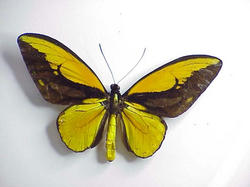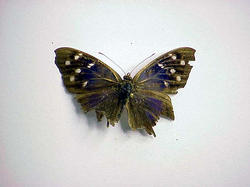[ B ] DESIGNATION
Grading specimens as [ B ] ----- for 10% to 45% of Top Dollar
1. Specimen is a rough example with very noticable flaws or missing parts that really DO detract from the appearance.
2. Substantial wing or body damage is apparent. Heavy wear, splits, rubs, or chips may be evident.
3. Missing body parts like antennae is allowable.
4. It is as though the specimen flew through a battle. It represents the species and is not even close to being a decent/good specimen.
5. Such a grading might also include a poor mounting job like large holes where pins slipped, broken and or badly crimped veins, or very large chunks of wings being gone.
Note 1: Really, this specimen is barely too good to toss in the garbage and may very well become 'spare parts' material later on.
[ B ] Ornithoptera croesus ( top )
This upper view looks much better than the specimen really is. It was repaired quite heavily from underneath (see image below marked Verso). The FWs were tattered very much along the edges, but even as a B specimen (repaired) I purchased in the 1970s, it was worth doing work to make a battered beater look like it would in nature. This was my first O. croesus croesus and the collection date is from 1939. I just had to get it because when it was offered, even a poor specimen was far better than none at all.
[ B ] Papilio palamedes
This "beater" is nothing more than a representation of the species. It has no complete tail, is full of chips and scratches, has wing wear with a loose HW, and is missing an antenna. It is better than not having that species in the collection at all and that is about all one can say about it.
[ B ] Ornithoptera croesus ( Verso )
Here the Verso view shows the extensive repairs to the terrible FW edges, some repair to the HWs, and a nearly crushed abdomen. The goal was to make a B specimen look 'ok' from the top. At the time back then, I was quite proud to have it.



